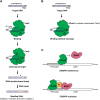Reprogramming Microbial CO2-Metabolizing Chassis With CRISPR-Cas Systems
- PMID: 35814004
- PMCID: PMC9260013
- DOI: 10.3389/fbioe.2022.897204
Reprogramming Microbial CO2-Metabolizing Chassis With CRISPR-Cas Systems
Abstract
Global warming is approaching an alarming level due to the anthropogenic emission of carbon dioxide (CO2). To overcome the challenge, the reliance on fossil fuels needs to be alleviated, and a significant amount of CO2 needs to be sequestrated from the atmosphere. In this endeavor, carbon-neutral and carbon-negative biotechnologies are promising ways. Especially, carbon-negative bioprocesses, based on the microbial CO2-metabolizing chassis, possess unique advantages in fixing CO2 directly for the production of fuels and value-added chemicals. In order to fully uncover the potential of CO2-metabolizing chassis, synthetic biology tools, such as CRISPR-Cas systems, have been developed and applied to engineer these microorganisms, revolutionizing carbon-negative biotechnology. Herein, we review the recent advances in the adaption of CRISPR-Cas systems, including CRISPR-Cas based genome editing and CRISPR interference/activation, in cyanobacteria, acetogens, and methanogens. We also envision future innovations via the implementation of rising CRISPR-Cas systems, such as base editing, prime editing, and transposon-mediated genome editing.
Keywords: CRISPR; acetogen; carbon dioxide; cyanobacteria; genome editing; methanogen.
Copyright © 2022 Yu, Wang and Xia.
Conflict of interest statement
The authors declare that the research was conducted in the absence of any commercial or financial relationships that could be construed as a potential conflict of interest.
Figures


References
Publication types
LinkOut - more resources
Full Text Sources

